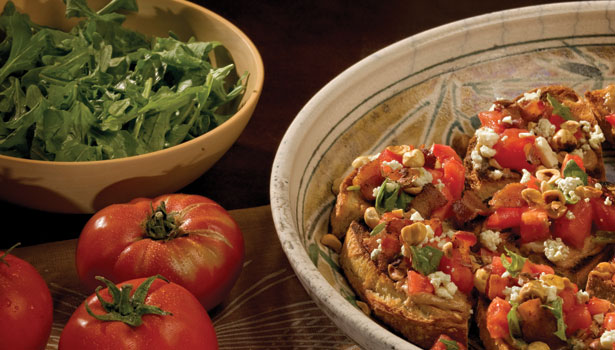A fruitful year


















Will supply for these ingredients be able to meet demand?
With recent record-breaking increases in commodity prices, bakers and snack producers are always keeping an eye on ingredient availability and cost, so they’ll be able to offer a variety of affordable favorites for the holidays as well as throughout the year. While the 2012 drought drove grain supplies down and prices up, government regulation continues to keep sugar prices high and unforeseen events often impact the availability and cost of spices produced in other parts of the world. Still, supplies of many U.S.-grown fruits and nuts are expected to be sufficient this year.
Tart treasures
When it comes to cranberries, the U.S. Cranberry Marketing Committee in Wareham, Mass., says it is confident that there will be an abundant supply of cranberries for today’s increasingly diverse array of cranberry-containing products, such as trail mixes, energy bars and cereals, as well as for dried cranberries, an evolving snack.
Dawn Gates-Allen, a fourth-generation cranberry grower and communications manager for the Cape Cod Cranberry Growers Association in Carver, Mass., agrees: “It’s shaping up to be a really good crop, we think. Because we had such a snowy winter, we really didn’t have to flood the cranberry bogs all winter. Typically, we flood the bogs, and they ice over. This entire winter, we might have had two to three weeks tops in January where we actually had ice on the bogs. The rest of the winter, the bogs were kept warm with snow, so the bud development is phenomenal. We’re just thrilled with the buds. We think we could have a really good crop here in Massachusetts.”
Gates-Allen also says she’s seeing cranberries being used in more consumer products. “[Manufacturers] are going gangbusters with introducing sweet, dried cranberries in a lot of the recipes, whether its granola, mixes, cookies or breads,” she explains.
Gates-Allen cites cranberries’ health benefits and extended shelf life as two reasons for the red orbs’ growing popularity among consumers. She acknowledges, however, that their tartness may deter some people from trying them. “Cranberries, by nature, are probably one of the lowest sugar-contented fruits out there,” she says. “So we as an industry are conscious that we have to do something to sweeten them to entice people to use them.”
Another tart fruit getting the nod from consumers and food producers is the cherry. “What’s happening is that bakers and manufacturers are beginning to blend tart cherries in with other fruit, like blueberries,” says Jeff Manning, chief marketing officer, The Cherry Marketing Institute, Lansing, Mich. “Tart cherries aren’t going to displace cranberries or blueberries. They’re going to be complementary and blended in because they add a different taste and color.”
Like dried cranberries, dried cherries are appearing in energy bars, granolas and snack mixes, while individually quick frozen (IQF) cherries are typically used in baked goods. “However, we are seeing some dried cherries come up on the baking side—scones, muffins, crisps, cobblers, that kind of stuff,” Manning notes.
With tart cherries finding their way into more baked goods and snacks, it’s a good thing that 2013 is looking better for the tart cherry industry and end users than it did in 2012. “We were affected by some very warm temperatures in Michigan in March [2012] and then a frost in April,” Manning explains. “It was a severe frost, and we lost most of that tart cherry crop.
“This year is looking much brighter and should be a rebound here for us. I’ve talked with people in Michigan, Utah and Washington—those are the three big growing areas—and, so far, the crop looks like a good to large crop.”
Sweet by nature
Like their tart, red counterparts, sweet highbush blueberries are expected be plentiful again this year. Continued acreage expansion and farming and processing efficiencies have resulted in larger crops each year. In 2012, for example, production of North American highbush blueberries was 559.4 million lb., up from 532.9 million lb. in 2011, according to the U.S. Highbush Blueberry Council (USHBC), Folsom, Calif.
Given the numerous formats in which blueberries are available—fresh, frozen, dehydrated, freeze-dried, concentrate, puree and powdered, to name a few—it’s no wonder that North American food processors developed numerous new products with blueberries in 2012. “Last year, new blueberry products surged to more than 1,300, and included everything from baby formulations to millennial choices and grown-up options,” says Thomas J. Payne, an industry consultant for USHBC.
“Popular as both healthy and delicious choices for all age groups and lifestyles, blueberries brightened energy bars, sparkled in sports beverages, dressed up breakfast cereals, waltzed into sauces, zoomed excitement through the dairy case and even delighted the family pet. Blueberries are [also] popular in trendy flavor pairings that are unusual and inspiring, making possible cookies and other ‘sweet’ snacks with a sly, savory side.”
Despite all the new applications for blueberries, the little blue gems continue to offer bakers an easy and affordable way to add color, texture, flavor, mouthfeel and nutritional benefits to bakery staples such as pies, bagels, muffins and scones.
As do raisins. “Even though exotic new fruits are coming aboard, California raisins, according to the [U.S. Department of Agriculture’s] Food-o-pedia website, remain the most economical dried fruit on the market in the U.S.,” says Larry Blagg, senior vice president, marketing, for the California Raisin Marketing Board in Fresno. “[They] contain zero empty calories as compared to a variety of sugar-added fruits that can have as much as 66 empty calories per serving.”
Besides being used in breads, bagels, cookies, muffins, bars and trail mixes, raisins now are appearing in traditional Mediterranean pizza crusts and calzone fillings, says Blagg. “The newest products with raisins are coming from whole-grain bakers and those who are developing gluten-free products,” he adds. “Craig Ponsford [of Ponsford’s Place, San Rafael, Calif.,] has developed a line of products that use raisins as a replacement for processed sugar.”
Regarding this year’s potential raisin supply, Blagg comments, “At this time of the year [early April], the big concern is if there is a freeze in the San Joaquin Valley before the grapes are really starting to grow. So far, so good. Very early indications are that the coming year’s crop will be bigger than last year’s, but no one is predicting total crop size.”
A tough nut to crack
Water, more than weather, is often a concern for U.S. nut growers, many of which are in California. Insufficient water supplies can impact crop size and prices.
“In 2008, when the drought was in full force [in California], our water was cut back 30%,” says George McManigle, president of the Gold Crown Macadamia Association (GCMA), Escondido, Calif., which represents macadamia growers in Southern California, from San Diego County up to Santa Barbara. “At that point, every grower in Southern California had to decide if they were going to cut back water by 30% for each tree or not water 30% of their trees. Of 100 macadamia nut trees, I capped the water on about 30 of them.”
Good snow packs in subsequent years improved conditions, and the region was unaffected by the drought that impacted much of the country last year. McManigle says the current macadamia crop looks good, but he expects it to be depleted by late August and to see subsequent back orders filled in January. “We do have some inventory right now—more than 95,000 lb.,” he adds.
But water supply isn’t the only factor affecting California’s macadamia nut industry. “Part of the problem we have is that the macadamia nuts that were planted in the highest volume were probably planted in the mid-70s,” explains McManigle. “Most of the people who did that are of an age where they’re not going out and picking them up. So the number of growers that the co-op has is steadily declining 1-2% each year because everyone’s getting older, and they’re not going out and harvesting the nuts. Harvesting macadamia nuts is pretty labor-intensive.”
Macadamia nuts, whole and pieces, will find their way into a host of products, including cookies, brownies, muffins, bars and nut mixes. The GCMA is developing some products as well, says McManigle. “One is going to be Cookies in a Jar,” he explains. “It’s a quart jar with all the ingredients layered into it. All you do is pour them into a bowl, add a couple of eggs and make your cookies with macadamia nuts.” The association plans to first offer the product on its website, to see what kind of response it receives.
“About 40% of California’s pistachio growers are in water-sensitive areas,” says Judy Hirigoyen, director of global marketing for the American Pistachio Growers, Fresno, Calif.. “While they received enough water for their orchards [last year]—pistachios are relatively drought-tolerant—the water came at a higher cost to the farmers. And water prices continue to rise.”
Asked about this year’s pistachio supply, Hirigoyen says pistachio trees “push out” a big crop every other year (an “alternate-bearing crop”). “This is an ‘off year,’ meaning a lower crop yield,” she explains. “Therefore, while last year’s crop harvested was about 555 million lb., this year we expect about 500 million lb. The additional acreage that will come into bearing will ease the supply situation. In terms of availability, it’s a variable, depending on demand.”
The pistachio forms that bakers and snack producers are requesting varies, too, depending on the application. “Some manufacturers use whole, halves and pieces,” says Kristi Robinson, who handles sales and marketing for Meridian Nut Growers, LLC, Clovis, Calif. “Some use diced pistachios. The demand for diced pistachios has increased in the last year.”
Jean-Yves Charon, a pastry chef and founder of Galaxy Desserts, Richmond, Calif., saw pistachios being used in many forms and creative ways during a recent stay in France. “I saw pistachio Paris-brest, [a traditional French pastry], which was really good,” he says. “I also saw pistachio crème in strawberry tartlets and an apricot tart with pistachio cream and diced pistachios on top.
“I find pistachios work very well with apricots and white chocolate. We create desserts for Williams-Sonoma, and they are introducing a pistachio croissant this year. [It’s] a very nice change from the usual almond croissants.”
For California almond growers, water restrictions weren’t an issue either last year (winter 2011-12). “However, this year is a different story,” says Mel Machado, field supervisor for Blue Diamond Growers in Sacramento, Calif. “The winter of 2012-13 has been quite dry, resulting in very low soil moisture levels as the growing season began. Allocations to districts on the west side of the San Joaquin River have been reduced to 20% of contracted amounts. Several irrigation districts east of the San Joaquin River that get their supplies directly from snowmelt run-off stored in Sierra Nevada reservoirs are also facing limitations this year, both in the amount of time water deliveries will be available and in the total amount of water available. Many growers will have to rely on their wells to supplement water at increased costs.”
Still, domestic shipments of California almonds are up 8% through February over the same time period last year (August-February), according to Bill Morecraft, general manager at Blue Diamond Almonds, Global Ingredient Division, Sacramento. “Total industry shipments from the California almond industry through February surpass last year by 0.5%,” he explains. “The 2012 crop supply is expected to be 2-3% less than the prior year. Industry inventories at the end of the 2012 crop season (July 31, 2013) project to be 250 million lb., both 25% lower and 85 million lbs. less than at the same time last year.”
Morecraft adds that, over the last month, almond prices have “gently softened from pre-bloom highs for most markets. Expectations for the spring and summer are for gradually firming prices for business delivered before 2013 crop availability.”
Versatility counts
Almonds’ versatility makes them suitable for a variety of baking applications. Sliced almonds can be used to top baked goods, almond paste can be used to create base layers in cakes or Danish, and almond meal can be used in gluten-free applications.
For snack foods, whole almonds tend to be popular in snack bars and mixes. “Blue Diamond is doing more with innovative flavors, where almonds can carry a flavor into the end application,” says Morecraft. “In this use, almonds not only carry the benefits of crunch and texture, but also can be used as a flavor carrier.”
Like Blue Diamond’s Machado, John Aguiar, sales director for Mariani Nut Co., says that “this spring and summer could provide challenges much like what we saw back in 2009, with water allotments being significantly reduced. As a result, some growers will be faced with very high costs of water during the growing season.” The Winter, Calif.-based company grows walnuts and almonds as well as buys these nuts from other growers.
Aguiar adds, though, that the company is hopeful that with its increasing acreage, walnut availability will be “excellent and a good value going forward.”
Manufacturers looking to expand their use of walnuts no doubt hope so, too. “In times past, bakeries would be focused on just a couple forms or sizes,” says Aguiar. “They are now seizing on positive consumer awareness of walnuts and looking across the spectrum to include walnuts in their products. From larger pieces all the way to walnut meal, we are seeing continued demand from that sector.”
From coast to coast
For hazelnut growers in Oregon’s Williamette Valley, water shortages and dry soil aren’t issues. The region is known for its abundant rainfall and fertile soil.
“It’s too early to know the crop size, but consensus is this will be a good crop, not exceptionally large or small,” says Polly Owen, manager for the Hazelnut Marketing Board, Aurora, Ore “So far, the weather has been good for crop development. For the crop to come in at optimal tonnage, the weather in the fall will need to cooperate.”
The confectionery segment, which uses more hazelnuts that any other food industry segment, according to Owen, and the pastry segment, the second largest hazelnut user, will no doubt be hoping that Mother Nature is in a cooperative mood, too.
Like other nuts, hazelnuts are used as whole kernels, diced kernels, meal, paste and butter. “We are seeing an increase in the use of paste and butter in hazelnut specialty pastries,” Owen adds. “Whether it is as a filling or a topping, the hazelnut flavor makes snack foods unique.”
On the other side of the country, Georgia’s pecan growers had one of their largest crops last year, despite being affected by the drought that plagued much of the U.S. in 2012, says Dr. Randall “Randy” Hudson, president of the Georgia Pecan Growers Association, vice president of the National Pecan Growers Council and a pecan farmer in Ocilla, Ga. “Currently, we have a really good supply of some very high-quality pecans in storage,” he says. “It’s reported to be in excess of 100 million pounds. There’s a good supply, particularly on some products.”
“The drought that we had the year prior impacted our yields significantly, particularly out West. It also impacted the quality. But, surprisingly, that area of the country came back with a pretty good crop last year. Texas, New Mexico and Arizona came back following that drought with a pretty good crop. As a result, we have seen recent prices lower than they were prior.”
Hudson says there are sufficient whole pecans and pecan pieces currently available for commercial baking and confectionery operations. “We have an abundant supply of pieces, and we have some of the best prices on pieces than we’ve had in several years,” he says. “On the other hand, halves are in short supply. The China market, which has been a huge market for the pecan industry the last couple of years, is a large in-shell pecan market. Large pecans shell out a higher percentage halves than pieces.”
While only Mother Nature knows for sure what this year holds for U.S. fruit and nuts producers, the 2013 growing season seems to be off to a good start for many of them, which, hopefully, will mean a good finish for bakers and snack producers.
Looking for a reprint of this article?
From high-res PDFs to custom plaques, order your copy today!
















